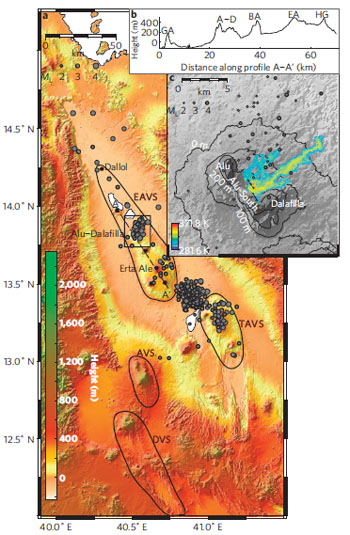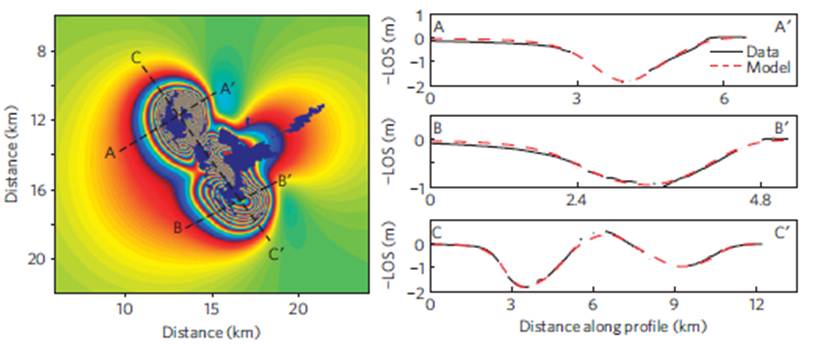
Figure 1: Location of the Erta Ale volcanic segment. a, Afar depression (Ethiopia). EAVS, Erta Ale volcanic segment; TAVS, Tat Ale volcanic segment; AVS, Alayta volcanic segment; DVS, Dabbahu volcanic segment. Circles represent earthquakes 2007–2009 in EAVS and TAVS. Hexagons mark volcanic centres of EAVS and the box marks the study area in c. b, Topography cross-section along A–A0, as marked in a. Volcanic centres: GA, Gada Ale; A–D Alu–Dalafilla; BA, Bora Ale; EA, Erta Ale; HG, Haily Gubbi. c, Alu–Dalafilla, the coloured area is the surface temperature of the lava flow erupted in 2008. The circles represent earthquakes from 2–3 November 2008.
Shallow axial magma chamber at the slow-spreading Erta Ale Ridge by Pagli et al, 2012
Non-technical summary
Mid-ocean ridges spread at different rates and have different topography. Fast-spreading ridges have elongated, shallow magma chambers beneath their axes and form topographic highs, whereas slow-spreading ridges have deeper magma chambers and form topographic lows along their axes. The presence or absence of a shallow magma chamber controls the topography and is thought to relate to the speed of spreading and the magma supply of a ridge. However, the slow-spreading Erta Ale segment of the Ethiopian Rift is dominated by active volcanism and the rift axis forms a topographic high.
In this paper InSAR data are used to investigate the Erta Ale segment of the Ethiopian Rift during an eruption in November 2008. InSAR is a widely used technique for monitoring changes of the Earth's surface. It measures variations in distance, to within a centimetre, between the satellite and the Earth's surface and so is used to show changes in the height of the ground.
A shallow, 1km deep, elongated magma chamber divided into two was found beneath the ridge with the eruption triggered by a small influx of magma into the northern part of this magma chamber. The eruption was fed from both parts of the magma chamber and both parts have refilled rapidly since the eruption ended. The presence of this unexpectedly shallow magma chamber beneath the slow-spreading Erta Ale rift segment suggests more than just the spreading rate and magma supply control the depth of magma chambers beneath rift axes. Additional factors maybe the presence of water and the resulting hydrothermal circulation, common beneath mid-ocean ridges, but lacking in desert environments such as Erta Ale; excessive magma production in the region; high frequency of magma-chamber replenishment and/or the proximity to the Afar plume.

Figure 2: Modelled interferogram and cross sections showing the change in the ground surface after the eruption across the area.
Full paper (PDF file)
